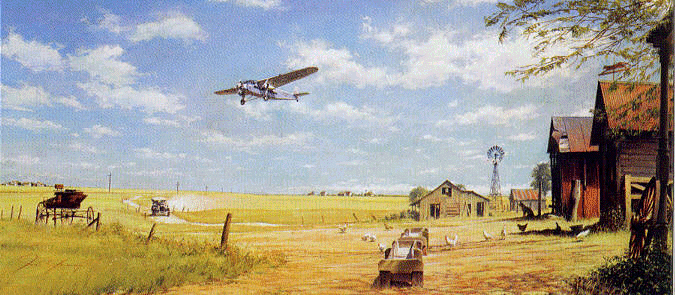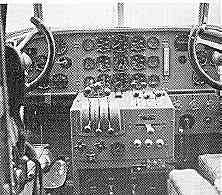The Story of the Ford Trimotor

From a painting called "Shrinking
Land" by John Young"http://www.oldgloryprints.com/aviation art.htm.
The Ford Trimotor: travel across America
takes days instead of weeks.
When in 1925 the Ford Motor Company took
over the Stout Aircraft Company it also acquired the designs of William B
Stout one of the best designers of light metal structures of the day. The
first and only result of the takeover of Ford in the field of aviation
would be the Ford 4-AT Trimotor, a powerful three-engined, high wing
monoplane constructed totally of metal, with a skin of corrugated
duralumin based on the Junkers system.  The German company in fact began a court action
against Ford for breach of patent. This meant that Ford had to provide
insurance to buyers of the aircraft in case Junkers, in turn, took
action against them. Notwithstanding, between June 1926 and September
1932, 195 Ford Trimotors were built, and flew with companies all over the
world.
The German company in fact began a court action
against Ford for breach of patent. This meant that Ford had to provide
insurance to buyers of the aircraft in case Junkers, in turn, took
action against them. Notwithstanding, between June 1926 and September
1932, 195 Ford Trimotors were built, and flew with companies all over the
world.
Henry Ford was,in fact, a visionary in aviation. He predicted that in the future airplanes would be, "made of metal, not wood, multi-engined, and monoplanes". Ford believed multi-engined planes would provide extra safety, as engines were very reliable. Also, monoplanes would not be subjected to the same icing conditions as biplanes, with their extra wings, struts, wires, etc.
Ford also founded it's own airline, and
pioneered radio air navigation. The first modern airport in America was in
Dearborn, Michigan, site of the present day Ford Museum. Runways were of
concrete, and about 1 mile in length. It took that much runway for the
lumbering Trimotors to get airborne.
The Ford Trimotor, robust and easy to maintain, had a fuselage of rectangular cross-section, rounded off fore and aft, built around a structure of multiple longitudinal spars, which together with the frames and skin carried most of the structural forces. The thick profile wing, also multi-sparred, was entirely made of metal including the skin. The aircraft had a wingspan of 22' 55 metres and its length was 15' 20 metres.
The empty weight was 3.150 kilos and its
maximum takeoff weight was 5.000 kilos.  It was powered by three Wright J-6 300 hp radial
engines. With a crew of two (pilot and radio operator or flight engineer)
its cabin could accomodate up to 12 passengers,
It was powered by three Wright J-6 300 hp radial
engines. With a crew of two (pilot and radio operator or flight engineer)
its cabin could accomodate up to 12 passengers, comfortably seated on wicker chairs, at a cruising
speed of 182 kilometres per hour over hour over a range of 850
kms.
comfortably seated on wicker chairs, at a cruising
speed of 182 kilometres per hour over hour over a range of 850
kms.
True or false?
Decide if the following statements are true or false:
Click the
button corresponding to your choice. If the buttons disappear your choice
was right.